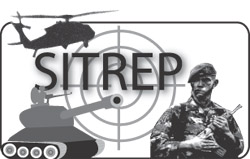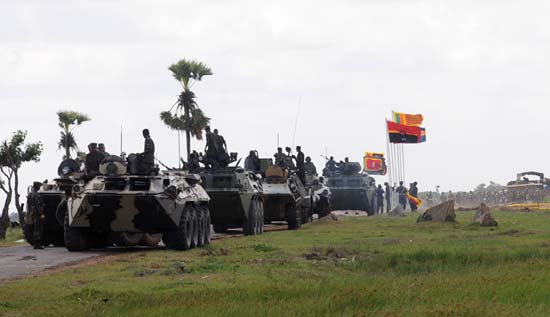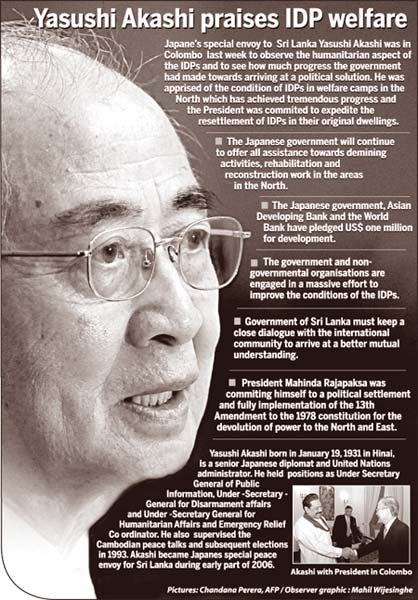International community changes tune
|

by Ranil Wijayapala |
As the hues and cries by certain international media and
international human rights organisations are fading away as they
themselves were not aware on what basis they have made those allegations
against the Sri Lankan Security Forces and the Government, the focus of
the international community is now drawn towards the Internally
Displaced People now housed in State run welfare centres in Vavuniya,
Mannar and Jaffna districts.
That was because many international media, mainly in the Western bloc
could not find any base for their false media reports which highlighted
that more than 20,000 civilians had been killed during the last stages
of the battle to rescue the last batch of civilians under LTTE
detention.
 Except for their assumptions and estimates, to prove their argument
they did not receive any backing except from the LTTE proxies operating
internationally to get the UN to probe into war crimes in Sri Lanka. So
many people who had been adversely critical of the Sri Lankan Government
and the Security Forces based on these false media reports, have had to
change their tune when speaking about Sri Lanka. Except for their assumptions and estimates, to prove their argument
they did not receive any backing except from the LTTE proxies operating
internationally to get the UN to probe into war crimes in Sri Lanka. So
many people who had been adversely critical of the Sri Lankan Government
and the Security Forces based on these false media reports, have had to
change their tune when speaking about Sri Lanka.
That was why a person like David Miliband, British Secretary of State
for Foreign and Commonwealth Affairs changed his tone on Sri Lanka’s
achievement against terrorism and had stated during his discussions with
Sri Lanka Foreign Minister Rohitha Bogollagama that the defeat of the
LTTE was a massive achievement by the Sri Lankan Government and none in
the British Government would shed any tears for these terrorists.
It very clearly shows that even those who had shed tears over the
LTTE had changed their attitude and accepting the fact that they were
supporting a terrorist organization. What they were discouraged in
persuading the UN to investigate in Sri Lanka was the strong support
extended by the international community towards the Sri Lankan
Government, rejecting all those false allegations by Western media.
The most obvious factor for the defeat of all those allegations was
that either Sri Lankan Government or the Security Forces did not commit
war crimes even at the last moment of the battle. So there was no reason
for them to panic about those false allegations as they did their best
to safeguard the lives of the civilians whilst fighting to defeat the
LTTE.
If 20,000 civilians were killed during the last few days of the
battle, they could have easily found the bodies of those civilians and
can hear from each and every displaced civilian about it as the figure
suggests that one out of eight people have been killed in the last few
days of the battle as 85,000 people have reached military controlled
areas within the last five days.
Above all, as a journalist who visited No Fire Zone in Puthumathalan,
Vellamullivaikkal and Karayanmullivaikkal, as the battle was going in
those areas I can guarantee that no such crimes were committed by the
Security Forces against the civilians at any stage of the battle.
So the chapter about the false allegations about war crimes has
reached an abrupt end as all those who tried to find evidence to prove
those allegations have failed in those attempts once they realized the
fact they have gone after a mirage, like Prabakaran, the Tiger leader
who put the lives of the Tamil community in peril for over three
decades.
However, the chapter on the displaced civilians still remains a
challenge for the Government as many organizations are focusing their
attention towards the displaced civilians now living in welfare camps in
Vavuniya, Mannar and Jaffna districts.
According to latest count released by the United Nations’s Office for
the Co-ordination of Humanitarian Assistance, between October 27 of last
year and June 8 of this year, 280,812 people crossed to the
Government-controlled areas from the conflict zone, including 3,194 who
were registered last week.
According to UN statistics as of June 8, the UN World Food Program (WFP)
had delivered nearly 880 metric tonnes of food to IDPs in Vavuniya.
The UN in its latest briefing on the Sri Lankan IDP situation, has
expressed their satisfaction over the manner Sri Lankan Government is
taking steps to provide facilities to these IDPs as Government has taken
initiatives to clear more areas in the Vauniya district to expand the
space for the welfare centres.
Currently, they are living in Kadirgamar, Ananda Coomaraswamy relief
villages in Zone I, Ramanathan relief village in Zone II, Arunachalam
welfare village in Zone III, and Zone IV and Zone V relief villages in
Settikulam.
Government is in the process of clearing land to expand the area to
establish relief villages in another zone. As of yesterday, Sri Lanka
had received US Dollars 69 million for the Common Humanitarian Action
Plan for Sri Lanka, out of the US Dollars 155 million required for this
purpose.
The most challenging situation is that there are 90,000 children
among 280,812 internally displaced civilians and the Government is
taking every possible step to provide them with basic healthcare and
food.
However, the Government, whilst taking steps to provide these IDPs
with the mostly needed facilities, it has also started the resettlement
of IDPs in the Mannar district after providing them with their basic
needs.
More than 5,000 people were resettled this week under the second
resettlement phase resettling in the Musali Division in Mannar district.
The challenge before the Security Forces, in the process of
resettling these civilians, is to provide them with safer environment
which is free of mines and unexploded devices. Apart from that, the
Security Forces and the Police are also making arrangements to establish
a better security network in the Wanni with the implementation of the
redeployment plan for Security Forces and the Police for the two
districts.
Arrangements
It was with that aspect in mind that the Sri Lanka Army established
two Security Forces Headquarters in Kilinochchi and Mullaitivu to
coordinate the security arrangements in the two districts and dominate
the area without keeping any room for the resurgence of terrorism in
that region.
The two new Security Forces Headquarters came into operation with
effect from June 5, 2009 with Major General Channa Goonetilleka General
Officer Commanding (GOC) for Security Forces Headquarters, Kilinochchi (KLN)
and Major General Nandana Udawatta, General Officer Commanding (GOC) for
Security Forces Headquarters, Mullaitivu assuming duties at their
respective offices.
They are responsible for the overall command, control and discipline
of all ranks under their command. Roles and responsibilities of both
Headquarters depend on operational requirements with expansion of civil
administration in the respective districts. With the setting up of these
two new Security Forces Headquarters the Sri Lanka Army has five
Security Forces Headquarters across the island.
Apart from establishing these two new Security Forces Headquarters,
the Sri Lanka Army will also go for a new redeployment plan in the two
districts very soon. According to the proposed redeployment plan, the
Sri Lanka Army seeks the approval of the Defence Ministry to form new
Army Divisions for the Kilinochchi and Mullaitivu Security Forces
headquarters apart from the existing Army Divisions. According to the
proposed redeployment plan, four Army Divisions will each come under
Mullaitivu and Kilinochchi Security Forces Headquarters. With the
implementation of this proposed redeployment plan in the Kilinochchi and
Mullaitivu districts, the possibility of terror activities in the
Mullaitivu and Kilinochchi jungles which were the breeding grounds for
LTTE terrorism will be totally eliminated if there is any attempt by
racist organisation to form a terror organisation like the LTTE.
In the same manner the Eastern Province will also be dominated by the
Security Forces deploying regular and volunteer battalions of the Army
into the jungles in the Trincomalee, Batticaloa and Ampara districts.
As a part of this redeployment plan, three regular battalions, 8
Gemunu Watch, 6 Vijayaba Infantry Regiment and 9 Armoured Corps
battalions which were deployed in the Kilinochchci and Mullaitivu
districts, were sent to the Batticaloa and Ampara districts. Apart from
this, three Volunteer Infantry battalions were also redeployed in the
East.
The Sri Lankan Air Force is also planning to establish two Air Force
bases in Iranamadu and Mullaitivu to make use of the two seized LTTE
constructed airstrips. The Sri Lanka Air Force believes that only the
two airstrips in Iranamadu and Mulliyavali in Mullaitivu can be
considered as original airstrips used by the LTTE although troops came
across more than 8 small air strips during the Wanni liberation
operation.
Therefore, the Air Force can only think of developing the Iranamadu
and Mulliyavali airstrips for the future use of the SLAF as it would
fulfill a long felt need in expanding its operations.
The SLAF, which played a keyrole in defeating the LTTE, by way of
supporting the ground troops and conducting independent combat
operations against the LTTE targeting their training and military bases,
their logistic bases and their leadership, yesterday marked the
culmination of air operations at the Air Force Base, Katunayake under
the supervision of Defence Secretary Gotabhaya Rajapaksa.
Morale
Defence Secretary Gotabhaya Rajapaksa paid a glowing tribute to the
Air Force for its contribution towards the victory by boosting the
morale of the ground troops by way of providing information about the
enemy ahead of them. The Defence Secretary also commended the Air Force
for its contribution to hold the ground captured by the ground troops
along with the Sri Lanka Army.
The Sri Lanka Navy too will have to ready just their security plan to
meet the future challenges as Sri Lanka is going to claim a sea area 23
times bigger than its land area very soon.
 Environment Minister Champika Ranawaka this week stated that Sri
Lanka’s proposals to claim the said sea area under Sri Lankan territory
was handed over on the very same day the Army troops advanced from the
South to North and from the North to South linking up at
Vellamullivaikkal on May 16. Environment Minister Champika Ranawaka this week stated that Sri
Lanka’s proposals to claim the said sea area under Sri Lankan territory
was handed over on the very same day the Army troops advanced from the
South to North and from the North to South linking up at
Vellamullivaikkal on May 16.
Therefore, the Sri Lanka Navy will be entrusted with a massive sea
area to be patrolled in the future and will have to increase its blue
water capabilities to match these requirements.
As the three Armed Forces are readjusting their structures to face
the future challenges and to restore normality in the country, the Sri
Lanka Police is also planning to establish 21 Police stations in the
North to facilitate the restoration of civil administration in the
Kilinochchi and Mullaitivu. These new Police stations will be
established in Mannar, Mullaitivu and Mankulam divisions in the North.
Inspector General of Police Jayantha Wickremaratne has also proposed
to establish a Tamil Language Training Centre in Kilinochchi which is a
prerequisite in the process of deploying Police personnel to these two
districts once the resettlement process has commenced.
The Police Department faced the same challenge in the Eastern
province but overcame it after recruiting qualified Tamil speaking
civilians to the Police Department to be deployed in Tamil speaking
areas in the Eastern province.
Thus, Police Department will have to improve the Tamil language
competency among Police officers to ensure that innocent Tamil
civilians, who are going to be resettled in their villages very soon,
will not face any inconvenience.
As Security Forces and the Police are laying a better security plan
for the North and East, the intelligence sleuths attached to the State
Intelligence Service are making further progress in their investigations
into the suicide attempts on the lives of President Mahinda Rajapaksa,
Defence Secretary Gotabhaya Rajapaksa and Army Commander General Sarath
Fonseka.The intelligence sleuths were able to uncover the links the LTTE
had with Security Forces personnel to accomplish their suicide missions
in Colombo.
The arrest of the Army Officer in charge of the Ratmalana Army
Transit Camp following the information received from the Tiger cadre who
committed suicide in May in an attempt to escape his arrest in
Wellawatte area had revealed many attempts by the LTTE to assassinate
the key persons behind these military successes.
Stringent
The most recent arrest of an LTTE mastermind, who had been operating
with the support of several others in Colombo, revealed that all three
attempts made on the lives of President Mahinda Rajapaksa and Defence
Secretary Gotabhaya Rajapaksa had failed due to tight security network
provided to them and the stringent Police arrangements.Information
provided by an arrested Tiger, who had received special training in
Kilinochchi for VIP assassination plans, has led State Intelligence
Service (SIS) sleuths to find four LTTE suicide jackets, concealed
inside the ceiling of a luxurious residential complex apartment in
Wellawatte on May 14, 2009.
However, the Tiger cadre committed suicide after jumping from the
seventh floor of the luxury flat he was residing when it was surrounded
by the Police.
He was later identified as Thamodarampillai Sujindran and was a
hardcore terrorist operating in Colombo for sometime.
Further investigations affirmed that a brother of the dead terrorist
is one of the three shareholders of the Wellawatte residential complex,
now living in London. Findings confirmed he himself was a hardcore LTTE
operative who had been actively involved in the LTTE’s international
network.
SIS investigators later on took his sister, mother and three more
youngsters studying in a private school in Wellawatte area into custody
for interrogation.
The first assassination attempt on the President, according to the
arrested Tiger, had been made while he was attending a passing out
parade at Diyatalawa military academy on December 20, 2008. A military
officer, Lt. Colonel Ranjith Perera who was arrested for having
connections with the LTTE, had been involved in the execution of those
plans.
The second assassination plan on the President was to be carried out
when he was participating in the “Deyata Kirula” exhibition at the BMICH
on April 4, 2009. The suicide bomber, in the guise of a soldier, had
sought permission to enter the premises in the company of Lt. Colonel
Ranjith Perera, but the senior Police officer in-charge of security at
the BMICH Gate-4 had strictly adhered to instructions of his superiors
to the letter and did not allow the terrorist and the military officer
to enter the BMICH premises where the President was to have visited.Thus
LTTE’s second attempt on the life of the President has ended in smoke,
the Court has been further told.
The third attempt to assassinate the President had also been boiled
at the Colombo National Hospital as the suicide cadre was late to reach
the hospital when President visited the hospital to see Minister Mahinda
Wijesekera who was seriously injured in the suicide bomb attack at
Godapitiya, Akuressa.According to investigations, the arrested Army
Officer had assisted the LTTE suicide cadres to travel free in Colombo
and suburbs and intelligence sleuths are investigating the links the
Army officer had with the LTTE with regard to the assassination of
Minister Jeyaraj Fernandopulle and also the suicide explosion near the
Air Force Headquarters on January 2, at the time President Mahinda
Rajapaksa was addressing the nation.
Those startling revelations will definitely lead to the Tiger links
in Colombo and will also clear the puzzles of the incomplete
investigations into many incidents that took place in Colombo.
|

